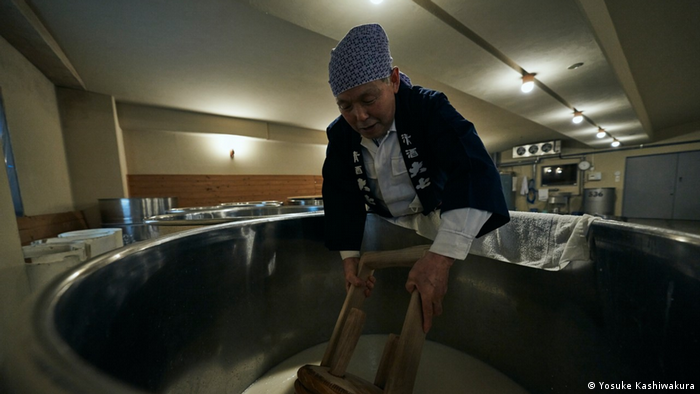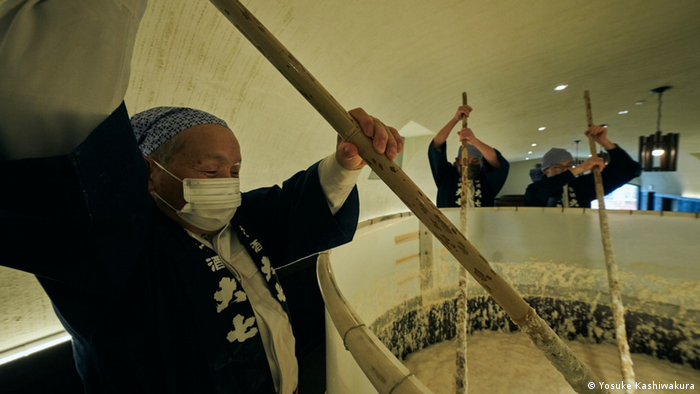Japan's national drink is growing in popularity in Europe. Although many exports are mass-produced, a few family-owned distilleries apply a slow, painstaking process they say creates the purest "kimoto" sake.
Hideharu Ohta absolutely refuses to take short-cuts. He is the tenth generation of his family to preside over operations at the Daishichi Sake Brewery, based in the Fukushima castle town of Nihonmatsu.
Ohta insists on adhering to a technique for making Japan's rice-based national drink that his ancestors used when they founded the brewery in 1752.
The "kimoto" method may be slower, more labor-intensive and makes the final product more expensive, but purists say the quality of the sake is as clear as the liquid itself.
And even though kimoto sake only accounts a fraction of the sake that is produced in Japan every year, it is finding a firm following overseas, including in Germany.
"My ancestors came to this part of Japan in the 1640s and opened the brewery some years later using the only technique that was available at the time, known as kimoto," Ohta told DW.
"Originally, sake was only available to priests and nobles, but in the early years of the Edo period [1603-1867] it was sold to commoners and the market expanded significantly," he said.
As the government relied heavily on taxes on alcohol, it encouraged manufacturers to adopt new technology that mass produced sake much more quickly and in larger quantities.
New versus old methods
Prompted by the government to adopt the new production methods, Ohta’s grandfather produced a batch but immediately discarded it as the taste and quality fell well short of what Daishichi drinkers would expect, he said.
It was decided to stick with the tried-and-tested techniques.
Creating kimoto sake requires the laborious and time-consuming preparation of the yeast required to cause fermentation.
The "yamaoroshi" process involves repeated mixing of the rice mash with long wooden paddles to bring out the strongest and most efficient yeasts. The entire process takes around 30 days from start to finish.
Modern sake, in contrast, typically utilizes industrially produced lactic acid that acts more rapidly, with bottling completed in a mere 20 days.
Ohta's ancestors also pioneered a number of other initiatives to enhance the flavor of their sake.
The "super-flat" rice polishing technique mills the external fats and proteins from individual grains of rice to the starch in their cores that is needed to produce alcohol.
A state-of-the-art anoxia filling system for bottles keeps air out to preserve the quality of the drink.
Daishichi's "Toji," or head brewer, Takanobu Sato has been recognized by the government as the top kimoto brewer in Japan and holds the title of the only contemporary master craftsman for sake in Japan.
The result is a range of sakes that have won countless awards. Daishichi was the official ceremonial drink for the enthronement of the Emperor Hirohito in 1926 and was served at the official dinner for the wives of the G-7 leaders at the 2008 summit in Hokkaido.
"The values that go into our sakes go far beyond efficiency in the production processes or convenience for the manufacturer," Ohta said. "In an age of mass production, we really do believe that a hand-crafted product is superior."
Sake a trending tipple in Germany
Ohta's sake is also attracting a following abroad, with around 10% of the brewery’s 900 kiloliter annual output going abroad, primarily to China, the US and, increasingly, Europe, including Germany.
Susanne Rost-Aoki in 2004 founded Sake Kontor in Berlin and told DW traditional sake works particularly well with German cuisine.
"The kimoto technique generally produces more acidity and amino acids and, for the palate of the average person in Germany, that is very good as it fits the desire for tastes and flavors that are a bit stronger than non-kimoto sake," she said.
"A sake that is richer in acidity and amino-acidity fits perfectly with traditional German food, like cheese and meat, even sausages," she said.
Rost-Aoki said Daishichi is an entry-level tipple that will even appeal to a sake beginner.
The more complex Minowamon, Masakura and Myoka Rangyoku labels "go far beyond this initial appeal and have so much more complexity and refinement that you feel like you never want to stop exploring," she said.
The average sake consumer in Germany is 30 or older and can afford a bottle that starts at about €30, Rost-Aoki said.
The market is aimed at international people with an interest in alternative, high-end cuisine, as well as those with a fascination with Japanese culture.
For these people, she adds, the "back story" of where the sake comes from and how it was made are critical.
"We do not import any sake that does not have a story," she said. "Our customers are always interested in who made the sake and we only sell sake from brewers that we know personally. I would guess that more than half of our work is telling the story behind the sake."
The German market for sake has been growing steadily since 2004, with Rost-Aoki confident that a great deal of potential remains as yet untapped.
Germany is at present the third-largest market in Europe, behind Great Britain and France, while a sake culture is also beginning to evolve in Belgium, Poland, Austria, Switzerland and other parts of Europe.
Edited by: Wesley Rahn
"traditional" - Google News
February 09, 2022 at 06:53PM
https://ift.tt/PRtT2CU
Japan's traditional sake makers preserve centuries-old distilling methods - DW (English)
"traditional" - Google News
https://ift.tt/i3ASsUB
Shoes Man Tutorial
Pos News Update
Meme Update
Korean Entertainment News
Japan News Update
Bagikan Berita Ini
















0 Response to "Japan's traditional sake makers preserve centuries-old distilling methods - DW (English)"
Post a Comment